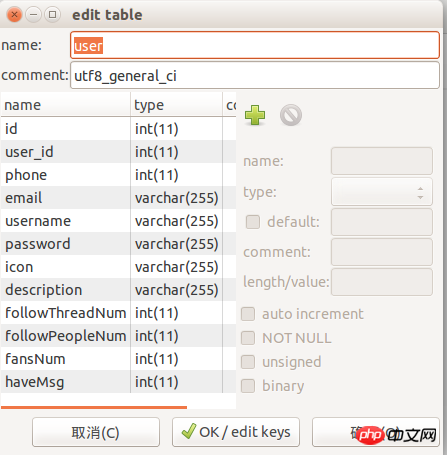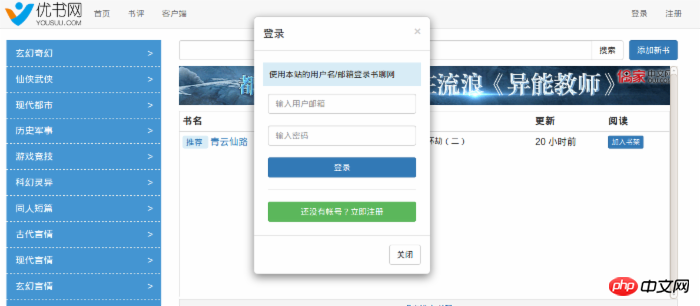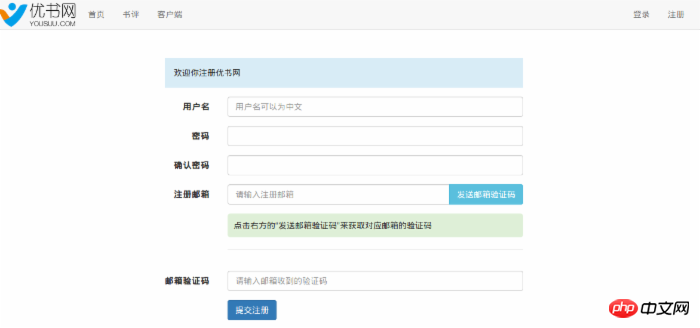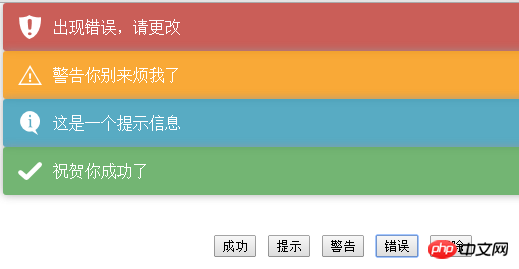
I haven’t been working on any projects recently, and I have nothing to do. I saw a bookstore website that was very good, so I copied it and used the UI directly. I wrote the front-end and back-end myself. Most of the functions have been implemented so far. .
1. Deployment of development environment
Program structure:
BootStrap Ajax Struts2 Hibernate MySql
For reference only: as long as relevant functions can be implemented
Operating system: ubuntu 14.10
Front-end framework: BootStrap Note: This framework is only for realizing the user interface and has nothing to do with specific functions
Database: mysql-5.5 Database tool: emma
Server: tomcat Server tool: Myeclipse 10 (Struts2 and Hibernate environments have been configured)
Note:
Program debugging process It's possible to get gibberish, just keep all tools encoding the same.
2. Project file configuration
1. Create a new Web Project and name it ROOT
2. Configure /WebRoot/ WEB-INF/web.xml
<?xml version="1.0" encoding="UTF-8"?>
<web-app xmlns:xsi="http://www.w3.org/2001/XMLSchema-instance"
xmlns="http://java.sun.com/xml/ns/javaee"
xsi:schemaLocation="http://java.sun.com/xml/ns/javaee http://java.sun.com/xml/ns/javaee/web-app_3_0.xsd"
id="WebApp_ID" version="3.0">
<display-name>ROOT</display-name>
<filter>
<filter-name>struts2</filter-name>
<filter-class>
org.apache.struts2.dispatcher.ng.filter.StrutsPrepareAndExecuteFilter
</filter-class>
</filter>
<filter-mapping>
<filter-name>struts2</filter-name>
<url-pattern>/*</url-pattern>
</filter-mapping>
<error-page>
<error-code>404</error-code>
<location>/error.jsp</location>
</error-page>
<error-page>
<error-code>500</error-code>
<location>/error.jsp</location>
</error-page>
<welcome-file-list>
<welcome-file>index.html</welcome-file>
<welcome-file>index.htm</welcome-file>
<welcome-file>index.jsp</welcome-file>
<welcome-file>default.html</welcome-file>
<welcome-file>default.htm</welcome-file>
<welcome-file>default.jsp</welcome-file>
</welcome-file-list>
</web-app>3, configuration/src/struts.xml (struts configuration file), other actions and interceptors were deleted by me, this is enough.
<?xml version="1.0" encoding="UTF-8" ?> <!DOCTYPE struts PUBLIC "-//Apache Software Foundation//DTD Struts Configuration 2.1//EN" "http://struts.apache.org/dtds/struts-2.1.dtd"> <struts> <package name="default" namespace="/" extends="struts-default"> <!-- 登录 --> <action name="login" class="com.action.Login" method="login"></action> <!-- 登出 --> <action name="logout" class="com.action.Logout" method="logout"></action> <!-- 注册 --> <action name="register" class="com.action.Register" method="register"></action> <!-- 邮件发送 --> <action name="sendmail" class="com.action.SendMail" method="sendmail"></action> </package> </struts>
4. Configure /src/hibernate.cfg.xml (hibernate database configuration file). Note that there is
<?xml version='1.0' encoding='UTF-8'?> <!DOCTYPE hibernate-configuration PUBLIC "-//Hibernate/Hibernate Configuration DTD 3.0//EN" "http://www.hibernate.org/dtd/hibernate-configuration-3.0.dtd"> <!-- Generated by MyEclipse Hibernate Tools. --> <hibernate-configuration> <session-factory> <property name="myeclipse.connection.profile">Myeclipse Mysql</property> <!--指明JDBC路径、指明数据库名称--> <property name="connection.url">jdbc:mysql://localhost:3306/test</property> <!--指明数据库账户和密码--> <property name="connection.username">root</property> <property name="connection.password">root</property> <!--指明JDBC驱动--> <property name="connection.driver_class">com.mysql.jdbc.Driver</property> <!--指明mysql方言--> <property name="dialect">org.hibernate.dialect.MySQLDialect</property> <property name="hibernate.current_session_context_class">thread</property> <property name="hibernate.dialect">org.hibernate.dialect.MySQLDialect</property> <property name="show_sql">true</property> <property name="format_sql">true</property> <mapping resource="com/hibernate/bookchat.hbm.xml" /> </session-factory> </hibernate-configuration>
5. Create the com.hibernate package under /src, create bookchat.hbm.xml (hibernate object relational mapping file) under this package, and configure
Note
<?xml version="1.0"?> <!DOCTYPE hibernate-mapping PUBLIC "-//Hibernate/Hibernate Mapping DTD 3.0//EN" "http://hibernate.sourceforge.net/hibernate-mapping-3.0.dtd"> <hibernate-mapping> <!--指明Bean类名,指明数据库表名--> <class name="com.hibernate.User" table="user"> <id column="id" type="int"> <generator class="native" /> </id> <!--指明数据库字段名、字段类型--> <property name="user_id" column="user_id" type="int" /> <property name="phone" column="phone" type="int" /> <property name="email" column="email" type="string" /> <property name="username" column="username" type="string" /> <property name="password" column="password" type="string" /> <property name="icon" column="icon" type="string" /> <property name="description" column="description" type="string" /> <property name="followThreadNum" column="followThreadNum" type="int" /> <property name="followPeopleNum" column="followPeopleNum" type="int" /> <property name="fansNum" column="fansNum" type="int" /> <property name="haveMsg" column="haveMsg" type="int" /> </class> </hibernate-mapping>
6 and /src in the next step.
package com.hibernate;
public class User {
private int user_id; //对应数据库中user_id
private int phone; //手机号
private String email; //邮件
private String username; //用户名
private String password; //密码
private String icon; //用户头像
private String description; //自定义描述
private int followThreadNum; //关注书单数量
private int followPeopleNum; //关注的人数量
private int fansNum; //粉丝数量
private int haveMsg; //当前是否有新消息
public User() {
super();
}
//这个构造方法在注册时有用
public User(String email, String username, String password) {
// 用户内容:username,password,email
// 系统定义:user_id,icon,followThreadNum,followPeopleNum,fansNum,haveMsg
// 留空:phone,description,
this.user_id = 39212;
// this.phone = phone;
this.email = email;
this.username = username;
this.password = password;
this.icon = "images/icon.png";
// this.description = description;
this.followThreadNum = 0;
this.followPeopleNum = 0;
this.fansNum = 0;
this.haveMsg = 0;
}
public int getUser_id() {
return user_id;
}
public void setUser_id(int user_id) {
this.user_id = user_id;
}
public int getPhone() {
return phone;
}
public void setPhone(int phone) {
this.phone = phone;
}
public String getEmail() {
return email;
}
public void setEmail(String email) {
this.email = email;
}
public String getUsername() {
return username;
}
public void setUsername(String username) {
this.username = username;
}
public String getPassword() {
return password;
}
public void setPassword(String password) {
this.password = password;
}
public String getIcon() {
return icon;
}
public void setIcon(String icon) {
this.icon = icon;
}
public String getDescription() {
return description;
}
public void setDescription(String description) {
this.description = description;
}
public int getFollowThreadNum() {
return followThreadNum;
}
public void setFollowThreadNum(int followThreadNum) {
this.followThreadNum = followThreadNum;
}
public int getFollowPeopleNum() {
return followPeopleNum;
}
public void setFollowPeopleNum(int followPeopleNum) {
this.followPeopleNum = followPeopleNum;
}
public int getFansNum() {
return fansNum;
}
public void setFansNum(int fansNum) {
this.fansNum = fansNum;
}
public int getHaveMsg() {
return haveMsg;
}
public void setHaveMsg(int haveMsg) {
this.haveMsg = haveMsg;
}
}7. Create the CreateTable class under the com.db package under /src, and then Run as - Java Application to check whether the console outputs the sql statement
package com.db;
import org.hibernate.cfg.Configuration;
import org.hibernate.tool.hbm2ddl.SchemaExport;
public class CREATTABLEDONOT {
public static void main(String[] args) {
// 默认读取hibernate.cfg.xml文件
Configuration cfg = new Configuration().configure();
SchemaExport export = new SchemaExport(cfg);
export.create(true, true);
}
}3. Check the database
1. Open the database GUI tool and check whether there is a user table under the test database. If the user table can be opened, it means that the previous configuration was successful.
2. Edit the user table: set the default value of the field and add data to the table.


4. Web UI design
1. We The foreshadowing has been laid in the struts.xml file configuration:
<action name="login" class="com.action.Login" method="login"></action> <action name="logout" class="com.action.Logout" method="logout"></action> <action name="register" class="com.action.Register" method="register"></action> <action name="sendmail" class="com.action.SendMail" method="sendmail"></action>
We can request /login, /logout, /register in the web page to access these three Action processing classes. Of course, the specific contents of these three classes We haven’t written it yet, so we’ll leave it alone.
2. Now start thinking about what is needed for web design...
<1> The homepage provides login and registration links

<2> Login pop-up box and registration page



5. JQuery Ajax design
1. Main JQuery and Ajax code(function(window, $) {
var SOKK = {};
ys.common = SOKK;
//邮箱验证
SOKK.sendmail = function(){
var email = $("#inputEmail").val().trim();
if(!checkEmail(email)){
return false;
}
//发送请求
$.get("/sendmail","email="+email,function(data){
data = JSON.parse(data);
tip(data.code);
})
}
//注册
SOKK.signup = function(form){
var form = $(form);
//成功方可继续执行
if(!checkSignUp(form.find("input")))
return false;
//序列化表单,生成JSON对象
var JStr =form.serialize();
// var JStr = JSON.stringify(JForm);
tip(JStr);
$.post("/register",JStr,function(data){
data = JSON.parse(data);
if (data.code == 200) {
location.reload(); //如何跳转到首页?
} else {
tip(data.code);
}
})
};
// 登录
SOKK.login = function(form) {
var form = $(form);
var input = form.find("input");
var username=$.trim(input[0].value);
var password=$.trim(input[1].value);
if(checkLogin(username,password)){
return false;
}
var dataParam = {};
dataParam.username = username;
dataParam.password = password;
// 这里的dataParam是键值对,但服务器获取的时候是?username=xx&password=xx;
// 如果使用json传输那么就不能用这种方式而必须用$.ajax,而且json在服务器端还要再解析,
// 所以在发送请求时,不建议使用json。接受数据可以使用json
$.post("/login", dataParam, function(data) {
// json字符串->json对象
data = JSON.parse(data);
if (data.code == 200) {
location.reload();
} else {
tip(data.code);
}
})
};
//登出
SOKK.logout = function(){
$.get("/logout", function (data) {
//json字符串->json对象
data = JSON.parse(data);
if (data.code==200){
location.reload();
}
})
};
})(window, $)// 自定义提示
function tip(info){
if(isNaN(info)){
toastr.info(info);
}else{
var msg;
if(info<300){
switch(info){
case 100: msg="加入书架成功!"; break;
case 101: msg="关注本书成功!"; break;
case 102: msg="已移动到【正在看】!"; break;
case 103: msg="已移动到【准备看】!"; break;
case 104: msg="已移动到【已看完】!"; break;
case 105: msg="已移动到【回收站】!"; break;
case 110: msg="验证邮件已发送到你的邮箱!";break;
case 200: msg="请求成功!"; break;
case 202: msg="请求已接受,但尚未处理。"; break;
case 204: msg="请求成功,但无返回内容。"; break;
default : break;
}
toastr.success(msg);
}else if(info<1000){
switch(info){
case 301: msg="请求网页的位置发生改变!"; break;
case 400: msg="错误请求,请输入正确信息!"; break;
case 401: msg="非法请求,未授权进入此页面!"; break;
case 403: msg="拒绝请求!"; break;
case 404: msg="请求页面不存在!"; break;
case 408: msg="请求超时!"; break;
case 500: msg="服务器出错!"; break;
case 500: msg="服务不可用!"; break;
case 900: msg="用户名/密码错误,请重新输入"; break;
case 903: msg="服务器出错,请重试!"; break;
case 904: msg="服务器无返回信息!"; break;
case 905: msg="网络出错!"; break;
case 906: msg="注册失败,请重试!";break;
case 907: msg="邮箱验证码错误!";break;
case 908: msg="用户名已存在!";break;
case 909: msg="邮箱已被注册!";break;
case 910: msg="验证邮件发送失败!";break;
default : break;
}
toastr.error(msg);
}else{
toastr.info(info);
}
}
}
//注册检查
function checkSignUp(input){
var username = $.trim(input[0].value);
var password1 = $.trim(input[1].value);
var password2 = $.trim(input[2].value);
var email = $.trim(input[3].value);
var emailcode = $.trim(input[4].value);
for (var i = 0; i < input.length; i++) {
if(input[i].value.length<=0){
tip("所有内容不得为空!");
return false;
}
};
if(username.length<4){
tip("用户名不得少于4个字符!");
return false;
}
if(password1!==password2){
tip("两次输入的密码不同!");
return false;
}
if(password1.length<6){
tip("密码不得少于6个字符!");
return false;
}
return true;
}
function checkLogin(username,password){
if(!username){
tip("请输入用户名!");
return false;
}
if(!password){
tip("请输入密码!");
return false;
}
}
function checkEmail(email){
var reg = /^([a-zA-Z0-9]+[_|\_|\.]?)*[a-zA-Z0-9]+@([a-zA-Z0-9]+[_|\_|\.]?)*[a-zA-Z0-9]+\.[a-zA-Z]{2,3}$/;
if(email){
if(reg.test(email)){
return true;
}else{
tip("邮箱地址不符合规范!");
return false;
}
}else{
tip("邮箱地址不得为空!");
return false;
}
} 
6. Action design
1、Login.javapackage com.action;
import javax.servlet.http.HttpServletRequest;
import org.apache.struts2.ServletActionContext;
import com.opensymphony.xwork2.ActionSupport;
import com.service.BaseService;
import com.service.BaseServiceImpl;
import com.util.OperateJSON;
public class Login extends ActionSupport {
private static final long serialVersionUID = 4679952956618457478L;
private String username;
private String password;
public void login() {
HttpServletRequest request = ServletActionContext.getRequest();
BaseService hs = new BaseServiceImpl();
OperateJSON oj = new OperateJSON();
username = request.getParameter("username");
password = request.getParameter("password");
System.out.println("用户名:" + username + "--密码:" + password);
// 登陆返回用户id
Object obj = hs.login(username, password);
if (obj != null) {
System.out.println("用户名密码正确");
request.getSession().setAttribute("username", username);
request.getSession().setAttribute("userid", obj);
System.out.println("用户名" + username + "的Session设置完毕~");
System.out.println("用户id的Session设置完毕~");
oj.putCode(200);
} else {
System.out.println("用户名密码错误");
oj.putCode(900);
}
oj.send();
}
}package com.action;
import javax.servlet.http.HttpServletRequest;
import javax.servlet.http.HttpServletResponse;
import org.apache.struts2.ServletActionContext;
import com.opensymphony.xwork2.ActionSupport;
import com.util.OperateJSON;
public class Logout extends ActionSupport {
private static final long serialVersionUID = -6758897982192371466L;
HttpServletRequest request = ServletActionContext.getRequest();
HttpServletResponse response = ServletActionContext.getResponse();
OperateJSON oj = new OperateJSON();
public void logout() {
request.getSession().removeAttribute("username");
request.getSession().invalidate();
if (request.getSession().getAttribute("username") == null) {
oj.putCode(200);
} else {
oj.putCode(903);
}
oj.send();
}
}package com.action;
import javax.servlet.http.HttpServletRequest;
import javax.servlet.http.HttpServletResponse;
import org.apache.struts2.ServletActionContext;
import com.hibernate.User;
import com.opensymphony.xwork2.ActionSupport;
import com.service.BaseService;
import com.service.BaseServiceImpl;
import com.util.OperateJSON;
public class Register extends ActionSupport {
private static final long serialVersionUID = -3356620731966076779L;
HttpServletRequest request = ServletActionContext.getRequest();
HttpServletResponse response = ServletActionContext.getResponse();
BaseService bs = new BaseServiceImpl();
OperateJSON oj = new OperateJSON();
SendMail sm = new SendMail();
public void register() {
String username = request.getParameter("username");
String password1 = request.getParameter("password1");
String password2 = request.getParameter("password2");
String password = (password1.equals(password2) ? password1 : null);
String email = request.getParameter("email");
String emailcode = request.getParameter("emailcode");
// 判断用户输入和生成的邮箱验证码是否相同
if (!(emailcode.equals(sm.getMailCode()))) {
oj.putCode(907);
oj.send();
return;
}
// 检测用户名/邮箱是否唯一
if (!bs.isUnique("User", "username", username)) {
oj.putCode(908);
oj.send();
return;
}
if (!bs.isUnique("User", "email", email)) {
oj.putCode(909);
oj.send();
return;
}
// 构建User对象
User user = new User(email, username, password);
// 建立对象关系映射
Boolean reged = bs.register(user);
if (reged) {
System.out.println("用户注册成功");
request.getSession().setAttribute("username", username);
oj.putCode(200);
} else {
System.out.println("注册失败");
oj.putCode(906);
}
oj.send();
}
}package com.action;
import java.util.Date;
import java.util.Properties;
import javax.mail.BodyPart;
import javax.mail.Message;
import javax.mail.MessagingException;
import javax.mail.Multipart;
import javax.mail.Session;
import javax.mail.Transport;
import javax.mail.internet.InternetAddress;
import javax.mail.internet.MimeBodyPart;
import javax.mail.internet.MimeMessage;
import javax.mail.internet.MimeMultipart;
import javax.servlet.http.HttpServletRequest;
import org.apache.struts2.ServletActionContext;
import com.opensymphony.xwork2.ActionSupport;
import com.util.OperateJSON;
public class SendMail extends ActionSupport {
private static final long serialVersionUID = -4724909293302616101L;
private static String QQ = "392102018"; // qq
private static String HOST = "qq.com"; // SMTP服务器主机名
private static String PASS = "xxxxxxxx"; // SMTP服务器密码
private static String mailCode; // 邮件验证码
OperateJSON oj = new OperateJSON();
public void sendmail() {
HttpServletRequest request = ServletActionContext.getRequest();
String email = request.getParameter("email");
System.out.println(email);
String mailCode = SendMail.setMailCode();
try {
beginSend(email, mailCode);
oj.putCode(110);
} catch (MessagingException e) {
oj.putCode(910);
} finally {
oj.send();
}
}
public static String setMailCode() {
mailCode = 100000 + (int) (Math.random() * 900000) + "BC";
System.out.println(mailCode);
return mailCode;
}
public String getMailCode() {
return SendMail.mailCode;
}
public void beginSend(String email, String mailCode)
throws MessagingException {
String mailTo = email; // 收件方mail地址
String mailTitle = "欢迎您使用书聊网! 立即激活您的账户";
String mailContent = "<p>尊敬的用户:</p><p>你好!立即激活您的账户,和书聊网会员一起看书交流。要激活您的账户,只需复制下面的验证码到注册页面确认。 </p>"
+ mailCode + "<p>版权所有© 1999 - 2015 BookChat。保留所有权利。</p>";
// 设置主要信息
Properties props = new Properties();
props.put("mail.smtp.host", "smtp." + HOST);
props.put("mail.smtp.auth", "true");
Session session = Session.getInstance(props);
session.setDebug(true);
// 开启邮件对象
MimeMessage message = new MimeMessage(session);
// 设置发件人/收件人/主题/发信时间
InternetAddress from = new InternetAddress(QQ + "@" + HOST);
message.setFrom(from);
InternetAddress to = new InternetAddress(mailTo);
message.setRecipient(Message.RecipientType.TO, to);
message.setSubject(mailTitle);
message.setSentDate(new Date());
// 设置消息对象内容
BodyPart mdp = new MimeBodyPart();// 新建一个存放信件内容的BodyPart对象
mdp.setContent(mailContent, "text/html;charset=utf-8");// 给BodyPart对象设置内容和格式/编码方式
Multipart mm = new MimeMultipart();// 新建一个MimeMultipart对象用来存放BodyPart对象(事实上可以存放多个)
mm.addBodyPart(mdp);// 将BodyPart加入到MimeMultipart对象中(可以加入多个BodyPart)
message.setContent(mm);// 把mm作为消息对象的内容
message.saveChanges();
// 开启传输对象
Transport transport = session.getTransport("smtp");
transport.connect("smtp." + HOST, QQ, PASS); // 这里的115798090也要修改为您的QQ号码
transport.sendMessage(message, message.getAllRecipients());
transport.close();
}
}package com.util;
import java.io.IOException;
import java.io.PrintWriter;
import org.apache.struts2.ServletActionContext;
import net.sf.json.JSONObject;
public class OperateJSON {
JSONObject json;
public OperateJSON() {
json = new JSONObject();
json.put("code", "");
json.put("msg", "");
json.put("data", "");
}
public OperateJSON(String str) {
json = JSONObject.fromObject(str);
}
public void put(String key, Object value) {
json.remove(key);
json.put(key, value);
}
public void putCode(Object value) {
json.remove("code");
this.put("code", value);
}
public void putMsg(Object value) {
json.remove("msg");
this.put("msg", value);
}
public void remove(String key) {
json.remove(key);
}
public void send() {
System.out.println("----------返回的数据是:" + json);
try {
PrintWriter out = ServletActionContext.getResponse().getWriter();
out.print(json);
out.flush();
} catch (IOException e) {
e.printStackTrace();
}
}
}7. Hibernate Dao design
This part is all about operating the database, everyone has his own style , just write it carefully. The code is too messy, so I won’t show it to scare people -.-!8. Summary
I wanted to show the results at first, but forget it, that’s all. A small example, flaws are inevitable, I hope the experts can correct me.I finished writing, and I feel much better. It’s okay to go to the job fair. It doesn’t matter whether I can find a job or not. What matters is that I am on the right path. Only by relying on myself can I be strong...
The above is what I compiled for everyone. I hope it will be helpful to everyone in the future.
Related articles:
Solution to prevent repeated sending of Ajax requests
How to solve the problem that error always pops up when ajax returns verification
The above is the detailed content of JQuery+Ajax+Struts2+Hibernate framework integration to achieve complete login registration. For more information, please follow other related articles on the PHP Chinese website!




